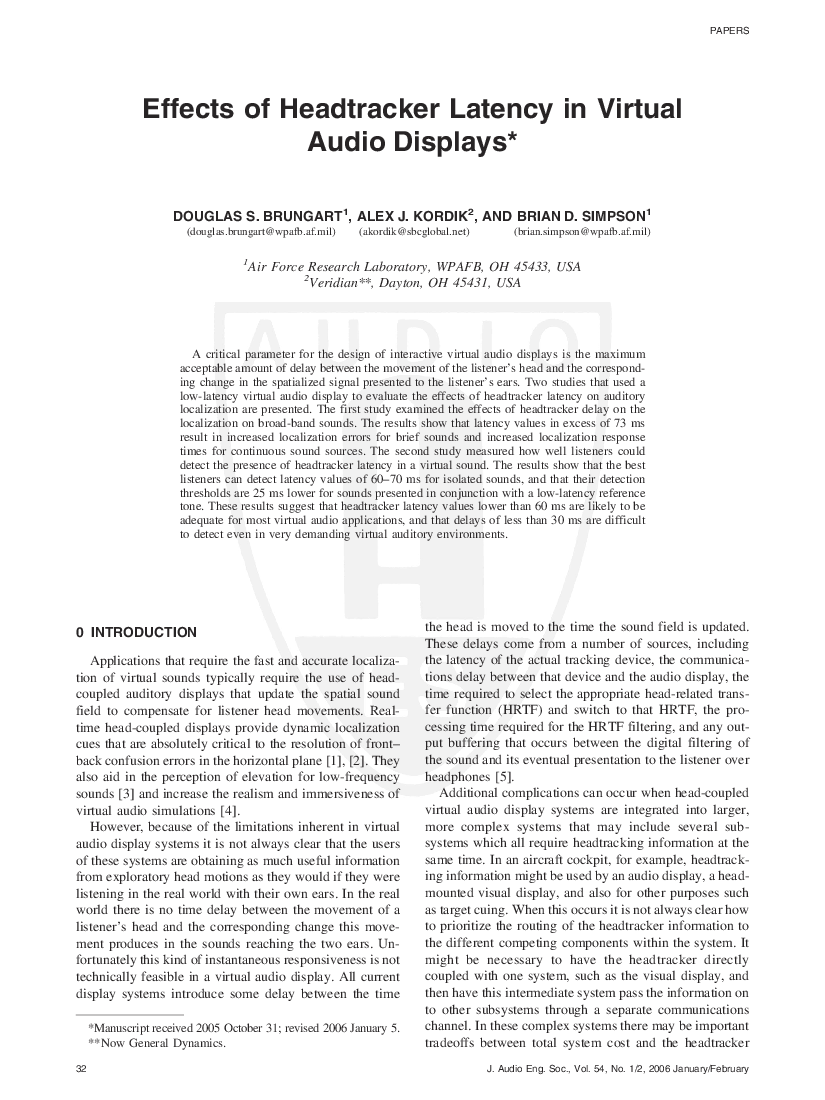Home / Publications / E-library page
You are currently logged in as an
Institutional Subscriber.
If you would like to logout,
please click on the button below.
Home / Publications / E-library page
Only AES members and Institutional Journal Subscribers can download
A critical parameter for the design of interactive virtual audio displays is the maximum acceptable amount of delay between the movement of the listener’s head and the corresponding change in the spatialized signal presented to the listener’s ears. Two studies that used a low-latency virtual audio display to evaluate the effects of headtracker latency on auditory localization are presented. The first study examined the effects of headtracker delay on the localization on broad-band sounds. The results show that latency values in excess of 73 ms result in increased localization errors for brief sounds and increased localization response times for continuous sound sources. The second study measured how well listeners could detect the presence of headtracker latency in a virtual sound. The results show that the best listeners can detect latency values of 60–70 ms for isolated sounds, and that their detection thresholds are 25 ms lower for sounds presented in conjunction with a low-latency reference tone. These results suggest that headtracker latency values lower than 60 ms are likely to be adequate for most virtual audio applications, and that delays of less than 30 ms are difficult to detect even in very demanding virtual auditory environments.
Author (s): Brungart, Douglas; Kordik, Alex J.; Simpson, Brian D.
Affiliation:
Air Force Research Laboratory, WPAFB, OH, USA; Veridian, Dayton, OH, USA
(See document for exact affiliation information.)
Publication Date:
2006-02-06
Import into BibTeX
Permalink: https://aes2.org/publications/elibrary-page/?id=13665
(322KB)
Click to purchase paper as a non-member or login as an AES member. If your company or school subscribes to the E-Library then switch to the institutional version. If you are not an AES member Join the AES. If you need to check your member status, login to the Member Portal.

Brungart, Douglas; Kordik, Alex J.; Simpson, Brian D.; 2006; Effects of Headtracker Latency in Virtual Audio Displays [PDF]; Air Force Research Laboratory, WPAFB, OH, USA; Veridian, Dayton, OH, USA; Paper ; Available from: https://aes2.org/publications/elibrary-page/?id=13665
Brungart, Douglas; Kordik, Alex J.; Simpson, Brian D.; Effects of Headtracker Latency in Virtual Audio Displays [PDF]; Air Force Research Laboratory, WPAFB, OH, USA; Veridian, Dayton, OH, USA; Paper ; 2006 Available: https://aes2.org/publications/elibrary-page/?id=13665
@article{brungart2006effects,
author={brungart douglas and kordik alex j. and simpson brian d.},
journal={journal of the audio engineering society},
title={effects of headtracker latency in virtual audio displays},
year={2006},
volume={54},
issue={1/2},
pages={32-44},
month={january},}